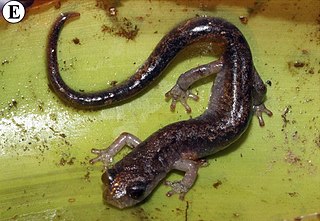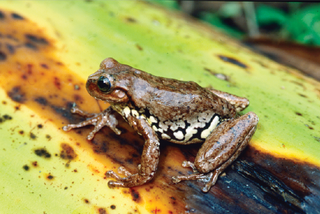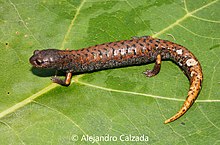
Charadrahyla is a genus of frogs in the family Hylidae. It is endemic to tropical southern Mexico. The generic name was derived from Greek charadra ("ravine") and Hyla, in reference to the habits of these frogs. Accordingly, common name ravine treefrogs has been coined for the genus.

Craugastor is a large genus of frogs in the family Craugastoridae with 126 species. Its scientific names means brittle-belly, from the Ancient Greek krauros and gastēr.
Pseudoeurycea orchileucos, commonly known as the Sierra de Juárez worm salamander, is a species of salamander in the family Plethodontidae. It is endemic to Oaxaca, Mexico, where it is known from the northern slopes of Sierra de Juarez at elevations of 800–1,390 m (2,620–4,560 ft) above sea level.
Pseudoeurycea orchimelas, commonly known as the San Martin worm salamander, is a species of salamander in the family Plethodontidae. It is endemic to Veracruz, Mexico, where it is known from the Sierra de los Tuxtlas at elevations of 100–1,300 m (330–4,270 ft) above sea level.
Parvimolge is a genus of salamanders in the family Plethodontidae, the lungless salamanders. It is currently considered as monotypic, although this may yet change as molecular data suggest that it is embedded within a paraphyletic Pseudoeurycea. Parvimolge townsendi is endemic to the northern Sierra Madre de Oaxaca in central and southern Veracruz, Mexico, between 900 and 1900 meters elevation. It is represented by the species Parvimolge townsendi, commonly known as Townsend's dwarf salamander.

Pseudoeurycea aurantia, commonly known as Peña Verde salamander, is a species of salamander in the family Plethodontidae. It is endemic to Oaxaca, Mexico and only known from its type locality near Peña Verde, which is the northernmost high peak in the Sierra de Juárez.

Pseudoeurycea lynchi, commonly known as the Veracruz green salamander, is a species of salamanders in the family Plethodontidae. It is endemic to the central Sierra Madre Oriental in Veracruz and Puebla states, Mexico.
The southern giant salamander is a species of salamander in the family Plethodontidae. It is endemic to Mexico and known from the Sierra Madre del Sur of western and southern Oaxaca and eastern Guerrero. It is the largest tropical salamander; the holotype had a total length of about 24 cm (9.4 in) and weighed 58 grams (2.0 oz).
Isthmura naucampatepetl, commonly known as the Cofre de Perote salamander, is a species of salamanders in the family Plethodontidae. It is endemic to the Sierra Madre Oriental in central Veracruz, Mexico, where it is known from between Cofre de Perote and Cerro Volcancillo, a satellite peak of Cofre de Perote.
The ridge tail salamander, also known as ridge-tailed salamander is a species of salamander in the family Plethodontidae. It is endemic to Oaxaca, Mexico, and only known from the area of its type locality on the mountain pass of Plan de Guadalupe in the Sierra de Mazateca, part of the Sierra Madre de Oaxaca, at 2,150 meters elevation. Future work might prove it to be more widespread than current records suggest. Its extent of occurrence is 10 km2.
The Cuetzalan salamander is a species of salamander in the family Plethodontidae. It is endemic to the Sierra Madre Oriental in Puebla, Mexico. Its specific name refers to its type locality, Cuetzalan del Progreso. Its natural habitat is cloud forest, but it also occurs in coffee groves. It has been found in a range of micro-habitats, such as under moss in rock walls, under stones, inside and under rotten logs, and in leaf axils. It might be threatened by habitat loss caused by human settlements and tourist development.

Pseudoeurycea ruficauda, also known as the orange-tailed agile salamander, is a species of salamander in the family Plethodontidae. It is endemic to the Sierra Mazateca, a part of Sierra Madre de Oaxaca of Mexico. The specific name ruficauda derives from the Latin words rufous (=reddish) and cauda (=tail) and refers to the reddish orange tail of this salamander. P. jaguar is its closest relative.
Thorius arboreus, commonly known as the arboreal minute salamander, is a species of salamander in the family Plethodontidae. It is endemic to Sierra de Juarez, Oaxaca, Mexico. The specific name arboreus, derives from the Latin word arbor, meaning tree, referring to the arboreal habitat of this species.
Thorius, also known as minute salamanders, pigmy salamanders, or Mexican pigmy salamanders, is a genus of salamanders in the family Plethodontidae. They are endemic to Mexico and found in southern Veracruz and Puebla to Guerrero and Oaxaca.
Thorius aureus, the golden thorius, is a species of salamander in the genus Thorius, the Mexican pigmy salamanders, part of the lungless salamander family. It is endemic to mountainous areas of north central Oaxaca State in Mexico. It is one of the largest Thorius species.
Jonathan Atwood Campbell is an American herpetologist. He is currently professor of biology at University of Texas at Arlington. He was a distinguished professor and chair of the Department of Biology, University of Texas at Arlington, Arlington, Texas.

Aquiloeurycea is a genus of salamanders in the family Plethodontidae. They are endemic to Mexico. The genus corresponds to the former "Pseudoeurycea cephalica species group", which was established in order to preserve Ixalotriton and Bolitoglossa while avoiding paraphyly of Pseudoeurycea.

Isthmura is a genus of salamanders in the family Plethodontidae. They are endemic to Mexico. The genus, which corresponds to the former "Pseudoeurycea bellii species group" and was first described as a subgenus of Pseudoeurycea, was raised to full generic level in 2015 in order to preserve Ixalotriton and Bolitoglossa while avoiding paraphyly of Pseudoeurycea.

Sarcohyla is a genus of frogs in the family Hylidae. It is endemic to Mexico and is found in the montane parts of the country between Durango in the north and Guerrero in the south. These frogs typically occur in pristine habitats along streams in pine-oak woodland at elevations between 1,500 and 3,100 m above sea level. The generic name is derived from the Greek sarkodes meaning "fleshy" in combination with Hylas and refers to the thick, glandular skin characteristic of most of the species in the genus.








